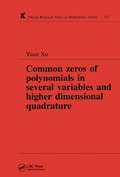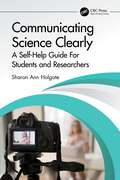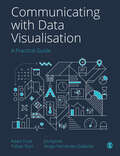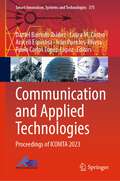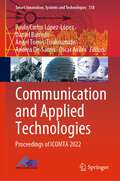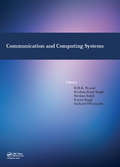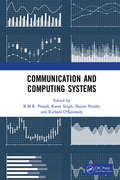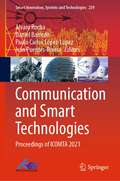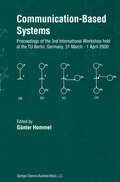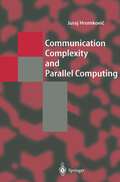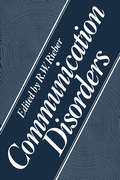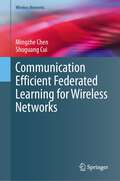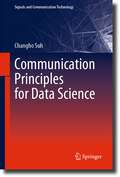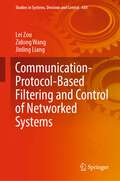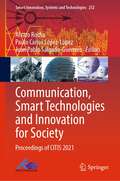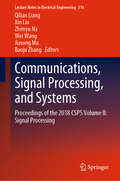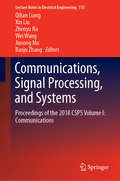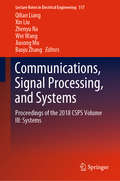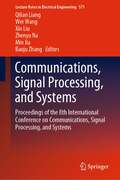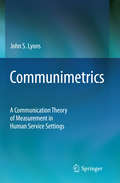- Table View
- List View
Common Zeros of Polynominals in Several Variables and Higher Dimensional Quadrature (Chapman And Hall/crc Research Notes In Mathematics Ser.)
by Yuan XuPresents a systematic study of the common zeros of polynomials in several variables which are related to higher dimensional quadrature. The author uses a new approach which is based on the recent development of orthogonal polynomials in several variables and differs significantly from the previous ones based on algebraic ideal theory. Featuring a great deal of new work, new theorems and, in many cases, new proofs, this self-contained work will be of great interest to researchers in numerical analysis, the theory of orthogonal polynomials and related subjects.
Communicating Science Clearly: A Self-Help Guide For Students and Researchers
by Sharon Ann HolgateThis unique self-help guide equips undergraduates, postgraduate students, and early career researchers within the sciences with transferrable communication skills that they can adapt and refer back to as they progress through their careers. It provides practical guidance on how to best communicate science in a range of different settings. This book facilitates clear and concise communication in both academic scenarios and the workplace. It covers settings ranging from job interviews, through conference presentations, to explaining your research to the general public. It is illustrated with first-hand experiences, top tips, and "dos and don’ts" to demonstrate best practices. It will also be a valuable guide for established academics who would like a refresher or a guide to new avenues of science communication, such as podcasts. Key Features: Written by an award-winning professional science journalist and broadcaster with 25 years’ experience, including writing for national newspapers, devising and presenting programmes for BBC Radio 4, and being interviewed on radio, TV, video, and podcasts Covers science communication in a broad range of settings including peer-to-peer, to your manager, at job interviews, and during media appearances Includes advice from a range of experts who communicate professionally, including a radio producer, a TV presenter, actors and entertainers, and scientists Additional video material to accompany this book can be found here: https://www.youtube.com/playlist?list=PLLUWyRwmgFlW7_NrNupeuiJ86OxIWHZ6I. Sharon Ann Holgate is a freelance science writer and broadcaster. She has presented on BBC Radio 4 and the BBC World Service, and presented video podcasts for medical research charity the Myrovlytis Trust. She earned a D.Phil in physics from the University of Sussex, where she was a Visiting Fellow in Physics and Astronomy for nine years. Her articles have appeared in Science, Science Careers, New Scientist, The Times Higher Education Supplement, The Times Literary Supplement, Flipside, E&T, Focus, Physics World, Interactions, Materials World, Modern Astronomer, and Astronomy Now. She was also shortlisted for the radio programme category of the Association of British Science Writers' Awards in 2005, and for the Aventis Prizes for Science Books Junior Prize in 2003. Dr. Holgate was the recipient of the Institute of Physics 2022 William Thomson, Lord Kelvin Medal and Prize for communicating science to a wide variety of audiences and for positive representations of scientists from non-traditional backgrounds. She has also received the Institute of Physics Young Professional Physicist of the Year Award and a Merit Award in the Daily Telegraph Young Science Writer of the Year competition. She is the author of the undergraduate textbook Understanding Solid State Physics, which is currently in its second edition and used as a core text in universities around the world.
Communicating Science Clearly: A Self-Help Guide For Students and Researchers
by Sharon Ann HolgateThis unique self-help guide equips undergraduates, postgraduate students, and early career researchers within the sciences with transferrable communication skills that they can adapt and refer back to as they progress through their careers. It provides practical guidance on how to best communicate science in a range of different settings. This book facilitates clear and concise communication in both academic scenarios and the workplace. It covers settings ranging from job interviews, through conference presentations, to explaining your research to the general public. It is illustrated with first-hand experiences, top tips, and "dos and don’ts" to demonstrate best practices. It will also be a valuable guide for established academics who would like a refresher or a guide to new avenues of science communication, such as podcasts. Key Features: Written by an award-winning professional science journalist and broadcaster with 25 years’ experience, including writing for national newspapers, devising and presenting programmes for BBC Radio 4, and being interviewed on radio, TV, video, and podcasts Covers science communication in a broad range of settings including peer-to-peer, to your manager, at job interviews, and during media appearances Includes advice from a range of experts who communicate professionally, including a radio producer, a TV presenter, actors and entertainers, and scientists Additional video material to accompany this book can be found here: https://www.youtube.com/playlist?list=PLLUWyRwmgFlW7_NrNupeuiJ86OxIWHZ6I. Sharon Ann Holgate is a freelance science writer and broadcaster. She has presented on BBC Radio 4 and the BBC World Service, and presented video podcasts for medical research charity the Myrovlytis Trust. She earned a D.Phil in physics from the University of Sussex, where she was a Visiting Fellow in Physics and Astronomy for nine years. Her articles have appeared in Science, Science Careers, New Scientist, The Times Higher Education Supplement, The Times Literary Supplement, Flipside, E&T, Focus, Physics World, Interactions, Materials World, Modern Astronomer, and Astronomy Now. She was also shortlisted for the radio programme category of the Association of British Science Writers' Awards in 2005, and for the Aventis Prizes for Science Books Junior Prize in 2003. Dr. Holgate was the recipient of the Institute of Physics 2022 William Thomson, Lord Kelvin Medal and Prize for communicating science to a wide variety of audiences and for positive representations of scientists from non-traditional backgrounds. She has also received the Institute of Physics Young Professional Physicist of the Year Award and a Merit Award in the Daily Telegraph Young Science Writer of the Year competition. She is the author of the undergraduate textbook Understanding Solid State Physics, which is currently in its second edition and used as a core text in universities around the world.
Communicating with Data Visualisation: A Practical Guide
by Adam Frost Tobias Sturt Jim Kynvin Sergio GallardoHow can you transform a spreadsheet of numbers into a clear, compelling story that your audience will want to pass on? This book is a step-by-step guide to bringing data to life through visualisations, from static charts and maps to interactive infographics and motion graphics. Introducing a four-step framework to creating engaging and innovative visualisations, it helps you to: · Find the human stories in your datasets · Design a visual story that will resonate with your audience · Make a clear, persuasive visual that represents your data truthfully · Refine your work to ensure your visual expresses your story in the best possible way. This book also includes a portfolio of best-practice examples and annotated templates to help you choose the right visual for the right audience, and repurpose your work for different contexts.
Communicating with Data Visualisation: A Practical Guide
by Adam Frost Tobias Sturt Jim Kynvin Sergio GallardoHow can you transform a spreadsheet of numbers into a clear, compelling story that your audience will want to pass on? This book is a step-by-step guide to bringing data to life through visualisations, from static charts and maps to interactive infographics and motion graphics. Introducing a four-step framework to creating engaging and innovative visualisations, it helps you to: · Find the human stories in your datasets · Design a visual story that will resonate with your audience · Make a clear, persuasive visual that represents your data truthfully · Refine your work to ensure your visual expresses your story in the best possible way. This book also includes a portfolio of best-practice examples and annotated templates to help you choose the right visual for the right audience, and repurpose your work for different contexts.
Communicating with Data Visualisation: A Practical Guide
by Adam Frost Tobias Sturt Jim Kynvin Sergio GallardoHow can you transform a spreadsheet of numbers into a clear, compelling story that your audience will want to pass on? This book is a step-by-step guide to bringing data to life through visualisations, from static charts and maps to interactive infographics and motion graphics. Introducing a four-step framework to creating engaging and innovative visualisations, it helps you to: · Find the human stories in your datasets · Design a visual story that will resonate with your audience · Make a clear, persuasive visual that represents your data truthfully · Refine your work to ensure your visual expresses your story in the best possible way. This book also includes a portfolio of best-practice examples and annotated templates to help you choose the right visual for the right audience, and repurpose your work for different contexts.
Communication and Applied Technologies: Proceedings of ICOMTA 2023 (Smart Innovation, Systems and Technologies #375)
by Daniel Barredo Ibáñez Laura M. Castro Araceli Espinosa Iván Puentes-Rivera Paulo Carlos López-LópezThis book features selected papers from the International Conference on Communication and Applied Technologies (ICOMTA 2023), jointly organized by the Colombian Association of Journalism and Science Communication (Colombia), and the Benemerita Universidad Autonoma de Puebla (Mexico); and as collaborators at the Universidad de Málaga (Spain), Universidade de Vigo (Spain), Universidade de Santiago de Compostela-Equipo de Investigaciones Políticas (Spain), Red Internacional de Gestión de la Comunicación (XESCOM),the International Media Management Academic Association (IMMAA), Red de Investigadores en Comunicación de Ecuador (RICE), and Observatorio Interuniversitario de Medios Ecuatorianos (OIME), during 6 – 8 September 2023. It covers recent advances in the field of digital communication and processes, digital social media, software, big data, data mining and intelligent systems.
Communication and Applied Technologies: Proceedings of ICOMTA 2022 (Smart Innovation, Systems and Technologies #318)
by Paulo Carlos López-López Daniel Barredo Ángel Torres-Toukoumidis Andrea De-Santis Óscar AvilésThis book features selected papers from the International Conference on Communication and Applied Technologies (ICOMTA 2022), jointly organized by the Universidad del Rosario (Bogotá, Colombia) and the Universidad Politécnica Salesiana (Cuenca, Ecuador), and as collaborators at the University of Vigo (Galicia, Spain), the University of Santiago de Compostela-Political Research Team (Galicia, Spain), and the Network of Communication Researchers of Ecuador (RICE), during August, 31–September 2, 2022. It covers recent advances in the field of digital communication and processes, digital social media, software, big data, data mining, and intelligent systems.
Communication and Computing Systems: Proceedings of the International Conference on Communication and Computing Systems (ICCCS 2016), Gurgaon, India, 9-11 September, 2016
by B.M.K. Prasad Krishna Kant Singh Neelam Ruhil Karan Singh Richard O’KennedyThis book is a collection of accepted papers that were presented at the International Conference on Communication and Computing Systems (ICCCS-2016), Dronacharya College of Engineering, Gurgaon, September 9–11, 2016. The purpose of the conference was to provide a platform for interaction between scientists from industry, academia and other areas of society to discuss the current advancements in the field of communication and computing systems. The papers submitted to the proceedings were peer-reviewed by 2-3 expert referees. This volume contains 5 main subject areas: 1. Signal and Image Processing, 2. Communication & Computer Networks, 3. Soft Computing, Intelligent System, Machine Vision and Artificial Neural Network, 4. VLSI & Embedded System, 5. Software Engineering and Emerging Technologies.
Communication and Computing Systems: Proceedings of the 2nd International Conference on Communication and Computing Systems (ICCCS 2018), December 1-2, 2018, Gurgaon, India
by B. M. K. Prasad Karan Singh Shyam S. Pandey Richard O'KennedyThe International Conference on Communication and Computing Systems (ICCCS 2018) provides a high-level international forum for researchers and recent advances in the field of electronic devices, computing, big data analytics, cyber security, quantum computing, biocomputing, telecommunication, etc. The aim of the conference was to bridge the gap between the technological advancements in the industry and the academic research.
Communication and Computing Systems: Proceedings of the International Conference on Communication and Computing Systems (ICCCS 2016), Gurgaon, India, 9-11 September, 2016
by B. M. K. Prasad Krishna Kant Singh Neelam Ruhil Karan Singh Richard O'KennedyThis book is a collection of accepted papers that were presented at the International Conference on Communication and Computing Systems (ICCCS-2016), Dronacharya College of Engineering, Gurgaon, September 9–11, 2016. The purpose of the conference was to provide a platform for interaction between scientists from industry, academia and other areas of society to discuss the current advancements in the field of communication and computing systems. The papers submitted to the proceedings were peer-reviewed by 2-3 expert referees. This volume contains 5 main subject areas: 1. Signal and Image Processing, 2. Communication & Computer Networks, 3. Soft Computing, Intelligent System, Machine Vision and Artificial Neural Network, 4. VLSI & Embedded System, 5. Software Engineering and Emerging Technologies.
Communication and Intelligent Systems: Proceedings of ICCIS 2023, Volume 3 (Lecture Notes in Networks and Systems #969)
by Lipo Wang Harish Sharma Vivek Shrivastava Ashish Kumar TripathiThis book gathers selected research papers presented at the Fifth International Conference on Communication and Intelligent Systems (ICCIS 2023), organized by Malaviya National Institute of Technology Jaipur, India, during December 16–17, 2023. This book presents a collection of state-of-the-art research work involving cutting-edge technologies for communication and intelligent systems. Over the past few years, advances in artificial intelligence and machine learning have sparked new research efforts around the globe, which explore novel ways of developing intelligent systems and smart communication technologies. The book presents single- and multi-disciplinary research on these themes to make the latest results available in a single, readily accessible source. The work is presented in three volumes.
Communication and Smart Technologies: Proceedings of ICOMTA 2021 (Smart Innovation, Systems and Technologies #259)
by Álvaro Rocha Daniel Barredo Paulo Carlos López-López Iván Puentes-RiveraThis book features selected papers from the International Conference on Communication and Applied Technologies (ICOMTA 2021), jointly organized by Universidad del Rosario (Bogotá, Colombia); the University of Vigo (Galicia, Spain); the University of Santiago de Compostela-Equipo de Investigaciones Políticas (Galicia, Spain); the University of A Coruña (Galicia, Spain); and the Information and Technology Management Association (ITMA), during September 2021. It covers recent advances in the field of digital communication and processes digital social media, software, big data, data mining, and intelligent systems.
Communication-Based Systems: Proceeding of the 3rd International Workshop held at the TU Berlin, Germany, 31 March – 1 April 2000
by Günter HommelProceedings of the 3rd International Workshop held at the TU Berlin, Germany, 31 March-1 April 2000
Communication Complexity and Parallel Computing (Texts in Theoretical Computer Science. An EATCS Series)
by Juraj HromkovičThe communication complexity of two-party protocols is an only 15 years old complexity measure, but it is already considered to be one of the fundamen tal complexity measures of recent complexity theory. Similarly to Kolmogorov complexity in the theory of sequential computations, communication complex ity is used as a method for the study of the complexity of concrete computing problems in parallel information processing. Especially, it is applied to prove lower bounds that say what computer resources (time, hardware, memory size) are necessary to compute the given task. Besides the estimation of the compu tational difficulty of computing problems the proved lower bounds are useful for proving the optimality of algorithms that are already designed. In some cases the knowledge about the communication complexity of a given problem may be even helpful in searching for efficient algorithms to this problem. The study of communication complexity becomes a well-defined indepen dent area of complexity theory. In addition to a strong relation to several funda mental complexity measures (and so to several fundamental problems of com plexity theory) communication complexity has contributed to the study and to the understanding of the nature of determinism, nondeterminism, and random ness in algorithmics. There already exists a non-trivial mathematical machinery to handle the communication complexity of concrete computing problems, which gives a hope that the approach based on communication complexity will be in strumental in the study of several central open problems of recent complexity theory.
Communication Disorders: (pdf) (Applied Psycholinguistics And Communication Disorders Ser.)
by R. W. RieberCommunication Efficient Federated Learning for Wireless Networks (Wireless Networks)
by Mingzhe Chen Shuguang CuiThis book provides a comprehensive study of Federated Learning (FL) over wireless networks. It consists of three main parts: (a) Fundamentals and preliminaries of FL, (b) analysis and optimization of FL over wireless networks, and (c) applications of wireless FL for Internet-of-Things systems. In particular, in the first part, the authors provide a detailed overview on widely-studied FL framework. In the second part of this book, the authors comprehensively discuss three key wireless techniques including wireless resource management, quantization, and over-the-air computation to support the deployment of FL over realistic wireless networks. It also presents several solutions based on optimization theory, graph theory and machine learning to optimize the performance of FL over wireless networks. In the third part of this book, the authors introduce the use of wireless FL algorithms for autonomous vehicle control and mobile edge computing optimization. Machine learning and data-driven approaches have recently received considerable attention as key enablers for next-generation intelligent networks. Currently, most existing learning solutions for wireless networks rely on centralizing the training and inference processes by uploading data generated at edge devices to data centers. However, such a centralized paradigm may lead to privacy leakage, violate the latency constraints of mobile applications, or may be infeasible due to limited bandwidth or power constraints of edge devices. To address these issues, distributing machine learning at the network edge provides a promising solution, where edge devices collaboratively train a shared model using real-time generated mobile data. The avoidance of data uploading to a central server not only helps preserve privacy but also reduces network traffic congestion as well as communication cost. Federated learning (FL) is one of most important distributed learning algorithms. In particular, FL enables devices to train a shared machine learning model while keeping data locally. However, in FL, training machine learning models requires communication between wireless devices and edge servers over wireless links. Therefore, wireless impairments such as noise, interference, and uncertainties among wireless channel states will significantly affect the training process and performance of FL. For example, transmission delay can significantly impact the convergence time of FL algorithms. In consequence, it is necessary to optimize wireless network performance for the implementation of FL algorithms.This book targets researchers and advanced level students in computer science and electrical engineering. Professionals working in signal processing and machine learning will also buy this book.
Communication Principles for Data Science (Signals and Communication Technology)
by Changho SuhThis book introduces the basic principles underlying the design and analysis of the digital communication systems that have heralded the information revolution. One major goal of the book is to demonstrate the role of the digital communication principles in a wide variety of data science applications, including community detection, computational biology, speech recognition and machine learning. One defining feature of this book is to make an explicit connection between the communication principles and data science problems, as well as to succinctly deliver the “story” of how the communication principles play a role for trending data science applications. All the key “plots” involved in the story are coherently developed with the help of tightly coupled exercise problem sets, and the associated fundamentals are explored mostly from first principles. Another key feature is that it includes programming implementation of a variety of algorithms inspired by fundamentals, together with a brief tutorial of the used programming tools. The implementation is based on Python and TensorFlow. This book does not follow a traditional book-style organization, but is streamlined via a series of lecture notes that are intimately related, centered around coherent storylines and themes. It serves as a textbook mainly for a junior- or senior-level undergraduate course, yet is also suitable for a first-year graduate course. Readers benefit from having a good background in probability and random processes, and basic familiarity with Python. But the background can be supplemented by almost self-contained materials, as well as by numerous exercise problems intended for elaborating on non-trivial concepts. In addition, Part III for data science applications should provide motivation and insights to students and even professional scientists who are interested in the field.
Communication-Protocol-Based Filtering and Control of Networked Systems (Studies In Systems, Decision And Control Ser. #430)
by Lei Zou Zidong Wang Jinling LiangCommunication, Smart Technologies and Innovation for Society: Proceedings of CITIS 2021 (Smart Innovation, Systems and Technologies #252)
by Álvaro Rocha Paulo Carlos López-López Juan Pablo Salgado-GuerreroThis book gathers high-quality papers presented at International Conference on Science, Technology and Innovation for Society (CITIS 2021), held in Guayaquil, Ecuador, on May 26–28, 2021. This book will present the recent research trends in the fields of software engineering, big data analysis, cloud computing, data engineering, data management and data mining, machine learning, deep learning, artificial intelligence, smart systems, robotics and automation, mechatronic design, and industrial processes design.
Communications, Signal Processing, and Systems: Proceedings of the 2018 CSPS Volume II: Signal Processing (Lecture Notes in Electrical Engineering #516)
by Qilian Liang Xin Liu Zhenyu Na Wei Wang Jiasong Mu Baoju ZhangThis book brings together papers from the 2018 International Conference on Communications, Signal Processing, and Systems, which was held in Dalian, China on July 14–16, 2018. Presenting the latest developments and discussing the interactions and links between these multidisciplinary fields, the book spans topics ranging from communications, signal processing and systems. It is aimed at undergraduate and graduate electrical engineering, computer science and mathematics students, researchers and engineers from academia and industry as well as government employees.
Communications, Signal Processing, and Systems: Proceedings of the 2018 CSPS Volume I: Communications (Lecture Notes in Electrical Engineering #515)
by Qilian Liang Wei Wang Jiasong Mu Baoju Zhang Xin Liu Zhenyu NaThis book brings together papers from the 2018 International Conference on Communications, Signal Processing, and Systems, which was held in Dalian, China on July 14–16, 2018. Presenting the latest developments and discussing the interactions and links between these multidisciplinary fields, the book spans topics ranging from communications, signal processing and systems. It is aimed at undergraduate and graduate electrical engineering, computer science and mathematics students, researchers and engineers from academia and industry as well as government employees.
Communications, Signal Processing, and Systems: Proceedings of the 2018 CSPS Volume III: Systems (Lecture Notes in Electrical Engineering #517)
by Qilian Liang Wei Wang Jiasong Mu Baoju Zhang Xin Liu Zhenyu NaThis book brings together papers from the 2018 International Conference on Communications, Signal Processing, and Systems, which was held in Dalian, China on July 14–16, 2018. Presenting the latest developments and discussing the interactions and links between these multidisciplinary fields, the book spans topics ranging from communications, signal processing and systems. It is aimed at undergraduate and graduate electrical engineering, computer science and mathematics students, researchers and engineers from academia and industry as well as government employees.
Communications, Signal Processing, and Systems: Proceedings of the 8th International Conference on Communications, Signal Processing, and Systems (Lecture Notes in Electrical Engineering #571)
by Qilian Liang Wei Wang Baoju Zhang Xin Liu Min Jia Zhenyu NaThis book brings together papers from the 2019 International Conference on Communications, Signal Processing, and Systems, which was held in Urumqi, China, on July 20–22, 2019. Presenting the latest developments and discussing the interactions and links between these multidisciplinary fields, the book spans topics ranging from communications to signal processing and systems. It is chiefly intended for undergraduate and graduate students in electrical engineering, computer science and mathematics, researchers and engineers from academia and industry, as well as government employees.
Communimetrics: A Communication Theory of Measurement in Human Service Settings
by John S. LyonsMeasurement in human services means one thing: how well the effort serves clients. But the data doesn’t exist in a vacuum and must be communicated clearly between provider and client, provider and management, and across systems. During the past decade, innovative communimetric measures have helped more than 50,000 professionals worldwide in health care, justice, and business settings deliver findings that enhance communication on all sides. Now, the theory and methods behind this fast-paced innovation are available in this informative volume. Communimetrics presents information in an accessible style, and its model of measurement as communication bolsters transparency and ease of interpretation without sacrificing validity or reliability. It conveys a deep appreciation for the unique position of service delivery systems at the intersection between science and management (and between quality and quantity), and shows readers how to create measures that can be used immediately to translate findings into practical action. This must-have volume offers readers the tools for understanding—and applying—this cutting-edge innovation by providing: The theoretical base for communimetrics. Practical illustrations comparing communimetrics with traditional methods. Guidelines for designing communimetric measures and evaluating their reliability and validity. Detailed examples of three widely used communimetric measures—the Child and Adolescent Needs and Strengths (CANS), the INTERMED, and the Entrepreneurial League System Assessment as well as detailed explanations for how they are used and why they work. Applications used in a range of settings, including children’s services, adult mental health, services for the aging, and business and organizational development. Communimetrics provides a wealth of real-world uses to a wide professional audience, including program evaluators, quality management professionals, enterprise managers, teachers of field research methods, and professionals involved in measurement and management design. It also makes an exceptionally useful text for program evaluation courses.
